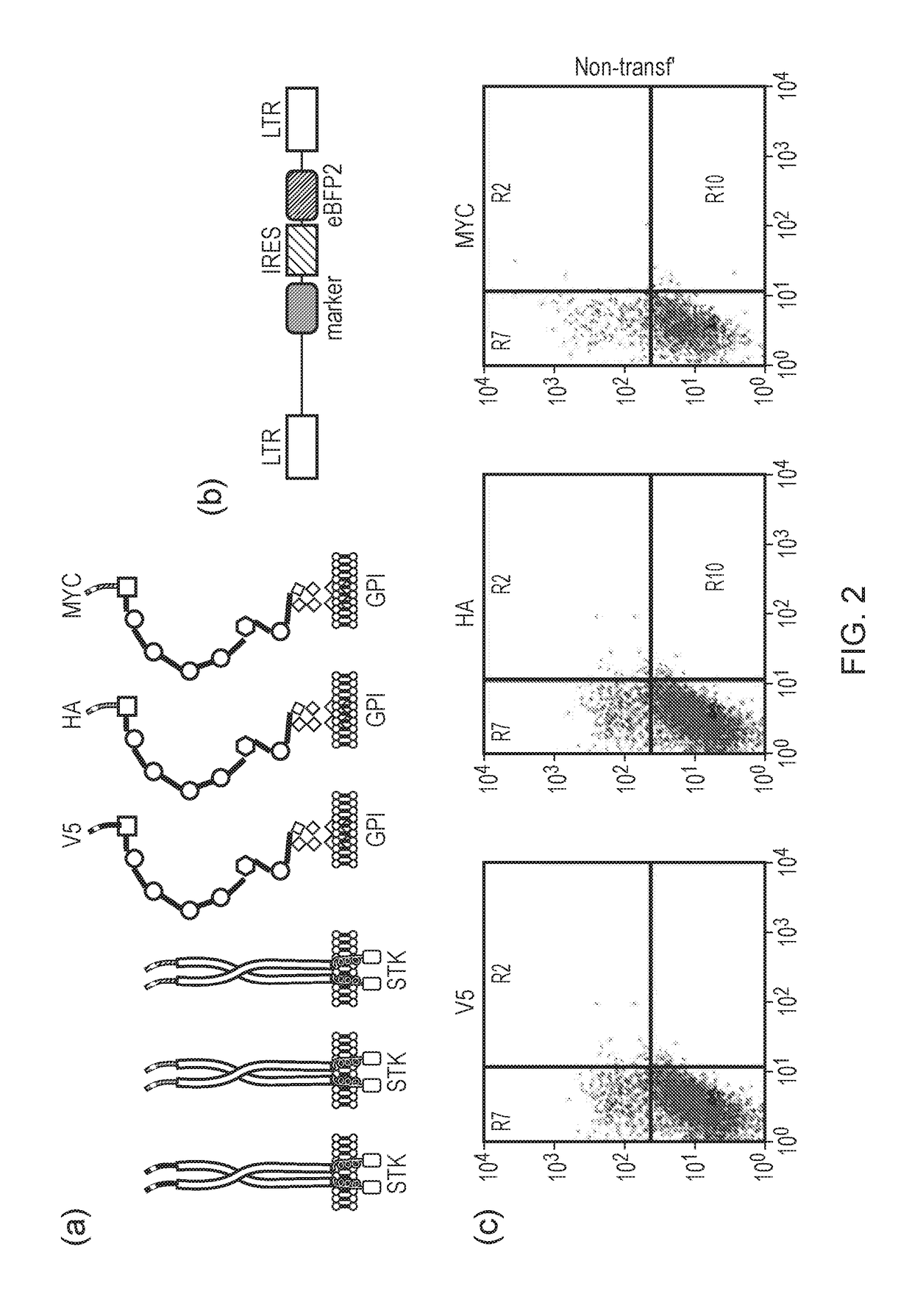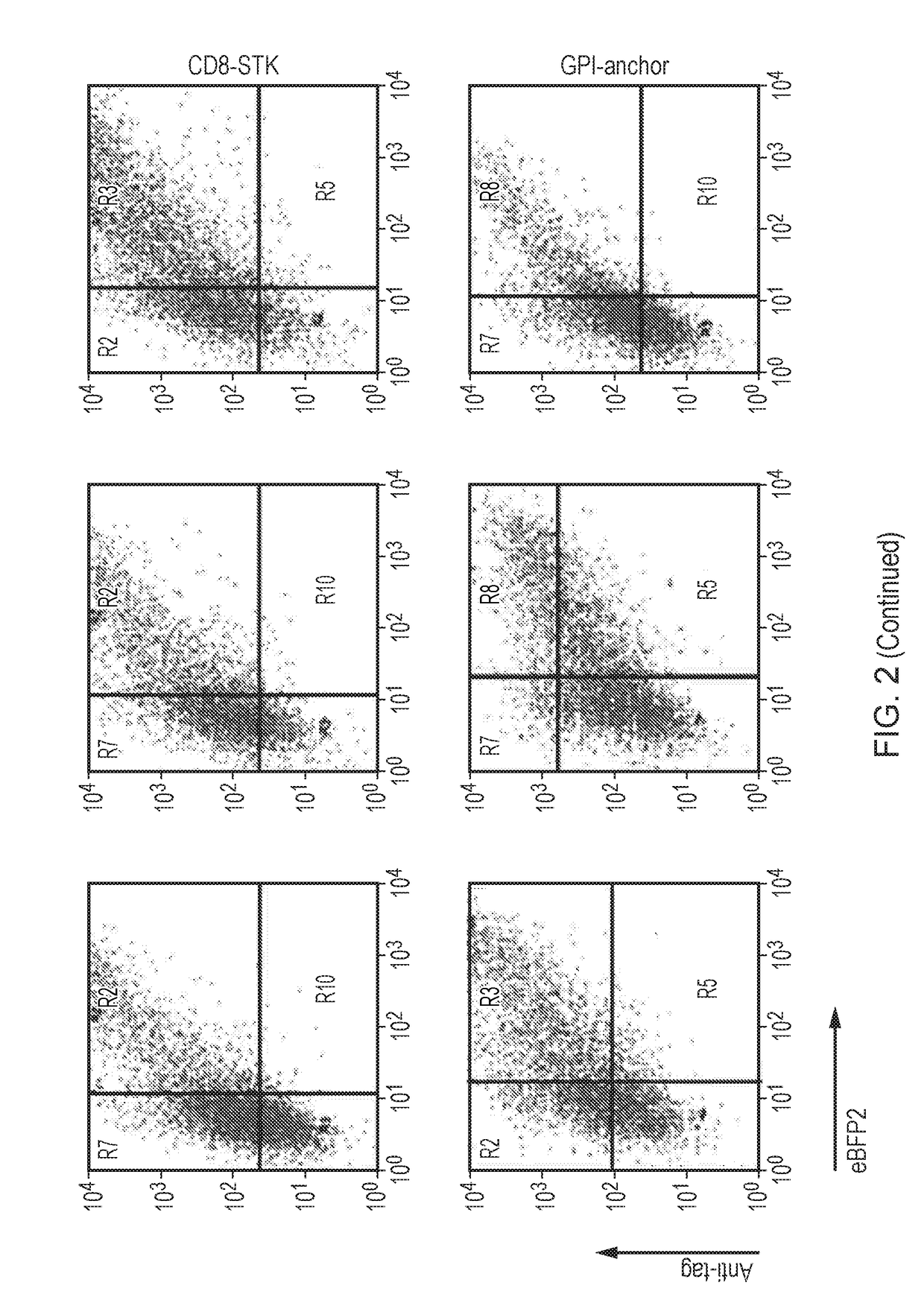Nucleic acid constructs for producing retroviral vectors
a technology of nuclear constructs and retroviral genes, applied in the field of retroviral genes, can solve the problems of hampered progress in lentiviral gene therapy, inability to use transient transfection technology to generate virus at an appropriate scale for clinical applications, and limited approach
- Summary
- Abstract
- Description
- Claims
- Application Information
AI Technical Summary
Benefits of technology
Problems solved by technology
Method used
Image
Examples
example 1
Construction of Cell Surface Marker Proteins
[0269]Possible compact surface marker genes are detailed in FIG. 2. Coding sequences for well-characterized epitope tags (V5, HA and MYC-tags) were cloned 3′ to the coding sequence for a signal peptide. These in turn were cloned to the stalk, TM and a portion of the endodomain of CD8alpha. Alternatively, they were cloned in frame with the GPI-anchor signal of CD52. This resulted in a set of highly compact surface marker proteins which display the epitope on the surface of the cell. This allows easy detection by staining with a fluorescently conjugated antibody. The compact size of these markers keep the transcriptional burden of expressing a marker gene to a minimum. Surface expression means the cell does not have to be lysed to allow detection.
example 2
Expression of Cell Surface Marker Proteins in 293T Cells
[0270]293T cells were co-transfected with a piggyBAC transposase expression plasmid and a lentiviral rev expression plasmid which also co-expressed V5-8 marker gene. Some 293T cells were also transfected with just the rev expression plasmid alone as a control. These latter cells allow determination of the contribution to expression from transient transfection as opposed to permanent insertion. At 10 days, both populations of cells as well as non-transfected controls were stained with a fluorescent antibody which recognizes the V5 epitope tag. These cells were then analysed by flow-cytometery. A clear population of V5-8 expression cells were seen in the transposase co-transfected cells, while expression in the rev expression alone 293T cells was lower (FIG. 3). These cell cultures were maintained for 95 days and periodically analysed for v5 epitope expression. This demonstrates the stability of piggyBAC mediated transposition, a...
example 3
Co-Expression of Different Lentiviral Proteins with Cell Surface Marker Proteins
[0271]Different lentiviral elements require different means to optimally co-express a marker gene. Lentiviral gagpol was tagged in two different ways: HA-8 tag marker gene was co-expressed with a FMD-2A like peptide, or with an IRES sequence (FIG. 4). Three lentiviral gagpol expression cassettes were tested: a control without a tag, the 2A-tagged version and the IRES-tagged version. 293T cells transfected with these plasmids were stained with an anti-HA antibody and analysed by flow-cytometry. The tag could be readily detected in both tag-2A and IRES.tag constructs. Lentiviral supernatant was generated by transiently transfecting helper plasmids and transfer vector where the gagpol was supplied by either one of the above three plasmids. Use of the Tag-2A construct resulted in a lower virus titer. This demonstrated that the IRES was an optimal way of tagging gagpol in this experiment.
PUM
| Property | Measurement | Unit |
|---|---|---|
| nucleic acid | aaaaa | aaaaa |
| structure | aaaaa | aaaaa |
| nucleic acid sequence | aaaaa | aaaaa |
Abstract
Description
Claims
Application Information
 Login to View More
Login to View More - R&D
- Intellectual Property
- Life Sciences
- Materials
- Tech Scout
- Unparalleled Data Quality
- Higher Quality Content
- 60% Fewer Hallucinations
Browse by: Latest US Patents, China's latest patents, Technical Efficacy Thesaurus, Application Domain, Technology Topic, Popular Technical Reports.
© 2025 PatSnap. All rights reserved.Legal|Privacy policy|Modern Slavery Act Transparency Statement|Sitemap|About US| Contact US: help@patsnap.com



